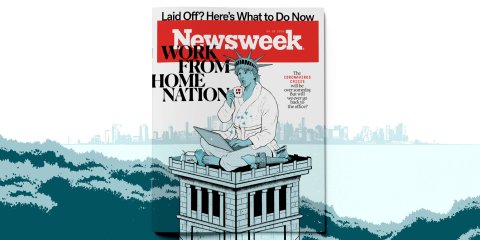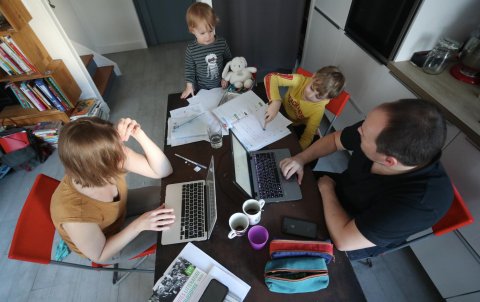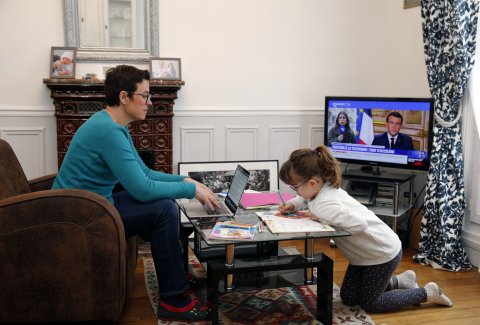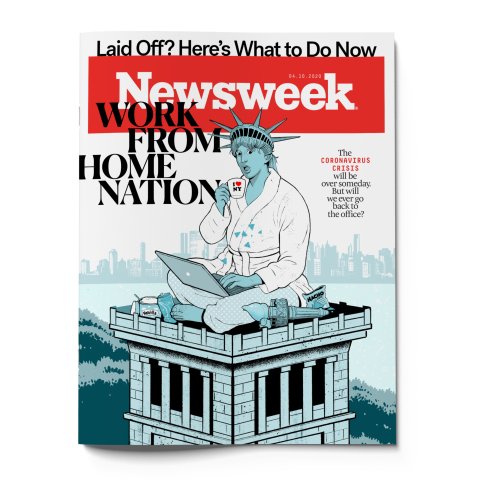It's been a couple of weeks now and here you are, slumped over the grimy keyboard of your laptop, unsure what day it is since you never go outside, and you've had these sweatpants on since...was it Wednesday?
The first few days were great. No need to put together an outfit, no reason to comb your hair or even look in the mirror. No commute! But unlike many things in life, working from home does not always get better with experience.
Life on lockdown isn't what you wanted, after all—and it may be what "office life" will be like from now on. The coronavirus pandemic has utterly disrupted the way millions of us work, and while the public health emergency will someday dissipate, some aspects of the Work From Home Revolution are likely here to stay.
"This may be the tipping point for remote work," says Kate Lister, president of consulting firm Global Workplace Analytics. "I don't think the office is going away, but more people will be spending at least part of the week at home."
There is already a measurable spike in the number of at-home workers. Gartner, a research and advisory firm, reports in a March 17 survey of 800 HR executives that 88 percent of the organizations have encouraged or required employees to work from home. G&S Business Communications, found in their own "snap poll" on March 21 that 26 percent of those surveyed have moved from the office to home.
Tech company services have also soared. FreeConferenceCall, a telecom service, says that usage in the U.S. is up 2,000 percent. (In Italy and Spain: 4,322 percent and 902 percent, respectively.) Kentik, a network analytics firm, says video-conferencing traffic has increased roughly 200 percent in North America and Asia.
In short: the pandemic has created a massive, forced socioeconomic experiment, with millions of Americans as the guinea pigs.

Prior to the outbreak, 69 percent of organizations already offered a remote work option on an ad hoc basis to at least some employees, while 42 percent offered it part time, and 27 percent offered it full time, according to SHRM's 2019 Employee Benefits Survey.
After the pandemic was declared, the trend accelerated. The usual suspects were the frontrunners: tech-centric companies like Microsoft and Amazon. But businesses in other industries have followed: automakers Ford, General Motors, and Fiat Chrysler have asked all global workers who can work from home to do so. Telecom giant AT&T and Wall Street banks, such as JP Morgan and Goldman Sachs? Same deal.
That's why Steve King, a partner at Emergent Research, a small business consultancy, says there may be no turning back. "If you already have a trend or shift that is growing, a shock like the coronavirus pandemic tends to be supportive of that, accelerating the trend," he says.
Since the virus was declared a pandemic on March 11, many companies have attempted to rapidly move their operations, culture, management style and communications fully online. Employees have longed for the flexibility that at-home work offers, and thousands of employers had encouraged remote work by eliminating private offices and putting open cubes in their place. The technology was already there from Slack, a messaging system, to Zoom video-conferencing.
But there are still downsides to this new remote-work reality. Many workers don't have the space at home and hate feeling isolated. It's harder to delineate personal and work time. (Does work interfere with Netflix binging or visa-versa?) Employers might not be prepared on the technology front. And furthermore, how do you know you're not paying someone to shop and FaceTime?
The recruiting company that Pamela Gonzalez, 24, works for in Orlando beefed up the hours for the tech department to install products like Google Voice and deal with problems related to remote setups. But as for the actual experience of working fully remote for the first time? Gonzalez says there's both good and bad.
The good: "I'm a lot more productive working from home, which surprised me," says Gonzalez, who began working remotely on March 17. "I feel like I don't have someone micromanaging me. I can work really hard for two hours and then take a break and come back." She adds: "In the office there are a lot more distractions."
The not so good: "It does mess with my work-life balance," Gonzalez says. "The first night I worked remotely, I ended up going back to my computer and working at 10 p.m. My boyfriend was not happy."
That double-edge to remote work, Gonzalez discovered, underpins one of the biggest misconceptions and key adjustments managers will have to make as they embrace a fully remote workforce.
A common reason employers cite for not offering remote work prior to the pandemic, Lister says, is simply that they don't trust their staff to work untethered. They fret that employees will use working hours for everything but the job at hand when they're out of sight. (Not that office workers don't do things like shop online and scroll Facebook on company time.)
In fact, 76 percent of HR leaders reported to Gartner that the top employee complaint during the coronavirus outbreak thus far has been "concerns from managers about the productivity or engagement of their teams when remote."
But many managers are likely to find themselves surprised. More than a quarter of workers who've recently switched to telecommuting say they're clocking more hours than they normally do in the office, according to a survey by G&S. And a study from Harvard University last year found that people were more productive when given the freedom to work from anywhere as opposed to strict workplace requirements.
Managers will also extrapolate from their own experience. "Working remote themselves is often what gets resistant managers over their reservations the quickest," says Lister. "They see how hard they are working while at home and the hours they're putting in still, and it helps them get over this issue of trust."
Employees will need to step up their communication, developing habits to document digital interactions so other teams and superiors know what's happening. And that sometimes means an overreliance on meetings. (Because everyone knows that more meetings create an illusion of productivity.) Only 3 percent of office workers attend 11 or more meetings a week, but 14 percent of remote workers do, according to a 2019 survey by Owl Labs.
Of course, productivity can only be so high if the necessary tools aren't also at home with you.
Not all at-home workspaces are created equal and employees may be held back initially if their companies haven't implemented the right technology. G&S found that 40 percent of Americans who've begun working remotely say one of the top challenges is setting up technology, like their phones and laptops. Managers seem to feel the same way. Gartner says about half of HR leaders surveyed admit that poor technology and infrastructure for remote working is the biggest barrier in the grand transition.

"Some of our developers [were] coming into the office anyway even though [we'd] been encouraged to work from home," says Doug Tabuchi, a lead engineer at SquareFoot, a New York-based real estate tech company, referring to the week before remote work was made mandatory on March 13. It was "a hassle to rebuild the setups and the operations they've come to expect and reply upon at the office."
And sometimes, he adds, it's the little things that add up. "I don't have a second monitor...I'm using AirPods instead of headphones and a microphone. It affects what I can get done." (It doesn't help that he lives in a one-bedroom apartment with a two-month old and his wife.)
Art Papas, chief executive of Boston-based software firm, Bullhorn, is learning as he goes along and has a different set of worries. He had a head start—about 20 percent of his 1,200 employees already were remote. That helps, but he's still concerned about lost productivity. There are a lot of things he finds easier done in person. "The biggest challenge is that teleconferencing takes more energy than an in-person meeting. It requires a different level of focusing and paying attention is harder."
But people will learn and adjust, he says: "just like any skill, remote work will take time." And the big plus, Papas adds: "No one is in traffic for two hours."
As employees get used to the benefits, the number of remote workers will rise; businesses can use it as a bargaining chip to recruit and retain top talent. "Companies will see remote work as a competitive advantage," says Dan Schawbel, managing partner of Workplace Intelligence. "Time and time again, workers have prioritized flexibility as part of their job search criteria—and now as they taste the benefits of it, the demand will only grow."
About half of America's on-site workers wanted remote work options before the pandemic hit, according to the Owl Labs survey. And more than a third of workers even said they'd be willing to sacrifice 5 percent of their pay for the option. But just because many employees may like having such flexible options, doesn't mean all of them will want to work remotely when the crisis ends. After all, companies such as IBM, Best Buy, Yahoo and Aetna experimented with remote work in years past and returned to the office.

"We make generalizations that this experiment will be good for remote work, but many people don't like always having to work remotely, especially under these circumstances. We can lose camaraderie and a sense of belonging the longer we are out of the office," says Johnny C. Taylor, Jr., president and CEO of the Society for Human Resource Management.
Those in-office connections aren't just good for workers' social lives and well being; they can be hugely beneficial to a company's bottom line. People with a "best friend" co-worker were seven times more likely to be engaged in their work, according to a study published in the Harvard Business Review. Another HBR study discovered that when a salesperson increased their interactions with co-workers by 10 percent, their sales also grew by 10 percent.
And for some, the convenience just doesn't trump the isolation—no matter how many video conferences you throw at them. "I'm an introvert who lives with a cat," says Justin Sanak, 29, who works for a government contractor in Plano, Texas. "I need time at home to recharge my batteries. But batteries aren't meant to be charging forever. I'm ready to be back at the office."

Clarification: This story has been updated to make clear that engineer Doug Tabuchi's remarks referred to the period before remote work was made mandatory.
About the writer
Kerri Anne Renzulli is personal finance journalist based in London; she's written for Money, Financial Planning magazine and CNBC.













